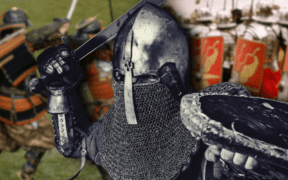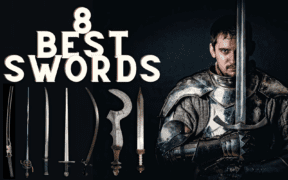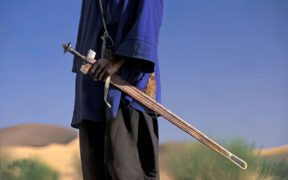African Sword Types: 14 Blades You Should Know About
NO AI USED This Article has been written and edited by our team with no help of the AI

African swords vary widely in design, broadly categorized into three groups: North African swords influenced by European and Arabic designs, Sahelian swords with a blend of North African and Sub-Saharan influences, and Sub-Saharan swords with distinct African styles due to less outside influence.
This article explores 14 African swords, their histories, and uses in African culture.
African Swords in History

There are many types of African swords due to Africa’s vast cultural diversity. However, we can only cover some of the most notable. For a more comprehensive list, be sure to check out our global sword list.
1. Khopesh

One of the earliest swords, the khopesh is an African sword that likely originated in ancient Egypt around 1800 BCE. Inspired by the epsilon axe, they were used in battles around the pyramids by Egyptians, sub-Saharan warriors in Nubia, and various cultures in the Mesopotamian Middle East.
- Design: Short, sickle-shaped, curved bronze blade with one-handed handle
- Uses: Combat, chopping, cutting
2. Takoba or Takouba

Inspired by European swords, Takoba or Takouba swords were used by the Tuareg and other groups in the Sahel. Native to modern-day Sudan, these swords were believed to have broad hilts that were made because the Tuareg were not permitted to touch iron which might have magical powers.
- Design: Straight, double-edged, broad blade varying in width and length with a simple crossguard and one-handed hilt.
- Uses: Combat (primarily cavalry), symbol of social status
“European swords with their straight blades and effective thrusting capabilities often made their way into Middle Eastern and African weapon arsenals through trade, war or sometimes the superior quality of craftsmanship,” says Matt Easton, a martial artist and antique arms dealer.
3. Shotel or Gurade

Originating in Ethiopia, shotels are designed to suit local fighting techniques often involving shield and sword combat. Mainly used by Ethiopian warriors, it hooks around shields and armor.
Historians believe that they may have been used from the 10th century and were still present during World War II. Straight-bladed versions are known as Gurade.
- Design: Typically single-edged, deeply curved, sickle-like shaped blade with hourglass handle made of wood or bone
- Uses: Combat
4. Kaskara

Inspired by European and Middle Eastern swords, the Kaskara dates back to the Middle Ages and reflects a blend of North African and Sudanese cultures. Simple to use, easy to produce, and effective in battle formations, Kaskaras were popular among many African tribes in Northeast Africa.
- Design: Straight, double-edged blade with a crossguard; flared tip on the leather scabbard
- Uses: Combat and ceremonial
5. Ngombe or Ngulu

The Ngombe, Ngulu, or Ngombe Ngulu is believed to hail from Central Africa and was used among the Mongo, Luba, and related groups in what is now Congo and its surrounding regions. The process of crafting this sword was highly labor-intensive.
- Design: Broad, curved, thick spine blade which is wider near the tip and narrows toward the handle; often features intricate cutouts or engravings
- Uses: Originally an executioner’s sword, ceremonial tool, status symbol
6. Nimcha

Nimcha are North African swords commonly used by various northwestern cultures in regions such as Morocco, Algeria, and Tunisia. Their exact historical origin date is not clear, but it became a very popular sword after the 16th century.
- Design: Curved, single-edged blade and elaborately decorated hilt; unique trait of having a third quillon on the guard.
- Uses: Combat, ceremonial tool, symbol of rank
7. Akrafena

A West African sword, the Akrafena (meaning “sword of the soul”) is the traditional sword of the Akan people, predominantly from the Ashanti Empire around modern-day Ghana. This sword is deeply rooted in the culture and can be categorized based on their purpose such as for public executions.
- Design: Typically short, broad blade that can be single- or double-edged; often features decorative patterns that hold cultural significance
- Uses: Ceremonial, symbol of authority, combat
8. Flyssa

The Flyssa is a traditional sword from the Kabyle people, an ethnic group native to the mountainous regions of modern-day Algeria. Due to its design, this sword was easy to produce, use, and practical for both foot and mounted combat.
- Design: Varying sizes of single-edged, straight, or slightly curved blade that gradually tapers to a sharp, narrow point; often feature intricate patterns
- Uses: Combat, status symbol, utility knives, cultural artifact
9. Ikakalaka or Kuba/Konda

The Ikakalaka or Kuba Konda is known for its intimidating appearance. Primarily associated with the Kuba and Mongo people of Congo, it comes in various shapes and designs, reflecting the culture of the region. Today, it continues to hold cultural significance and is used in martial arts training to explore historical techniques.
- Design: Broad, leaf-shaped blade with pronounced, curved silhouette; often asymmetrical and features elaborate engravings
- Uses: Ceremonial object, status symbol, cultural artifact
Regarding the lack of armor in African combat, Khari, a martial artist expert in HAMAA (Historical African Martial Arts Association) says, “There’s not a lot of armor (in African combat). There are various accounts of warriors going into battle with their armor and overheating before they got to the enemy.”
10. Bilao (Somali)

The Somali Bilao comes from the Horn of Africa, particularly Somalia. Forged from locally sourced steel using traditional skills, this sword reflects a combination of practicality and Somali artistry. It is often compared to the Roman gladius due to its tapering form.
- Design: Typically a single- or double-edged short, leaf-shaped blade with a small guard; Large, elaborate pommel has protrusions that enhance one’s grip
- Uses: Combat, utility tool, ceremonial object, status symbol, cultural artifact
11. Cimpada

Cimpada are traditional swords used by the Woyo people of Angola and Congo. In the 19th century, European traders acquired these swords, introducing the design to Western audiences. Several variations of the cimpada exist based on their purpose or function.
- Design: Short and broad with double-edged, leaf-shaped blade that tapers to a rounded or pointed tip
- Uses: Status symbol, spiritual significance, ceremonial use, family heirloom
12. Ida

The Ida is a traditional sword from Nigeria, associated with the Yoruba people and other ethnic groups in southwestern Nigeria. It is often associated with Ogun, the Yoruba god of iron, war, and craftsmanship. Several variations are available.
- Design: Short to medium-length single-edged blade that is broad, flat, and tapers to a rounded or slightly pointed tip
- Uses: Status symbol, ceremonial use, combat, utility tool
13. Ada/Omozo

The Ada or Omozo swords were traditionally used by the Edo people in the Kingdom of Benin. They are believed to have been in use from the 15th century but peaked in popularity from the 17th to 19th centuries.
- Design: Typically wide, flat, leaf- or fan-shaped blade that is narrower at the base and widens toward the tip
- Uses: Status symbol, ceremonial use, spiritual protection, icon of cultural heritage
14. Dahomey or Hwi

The Dahomey or Hwi sword is a traditional weapon associated with the Kingdom of Dahomey, a powerful West African kingdom from the 17th to 19th century. These swords were famously used by Dahomey Amazons, an all-female military regiment that was highly trained and fiercely loyal.
- Design: Typically double-edged, short, broad, leaf-like, or slightly curved blade with one-handed hilt
- Uses: Close combat, ceremonial use, status symbol





